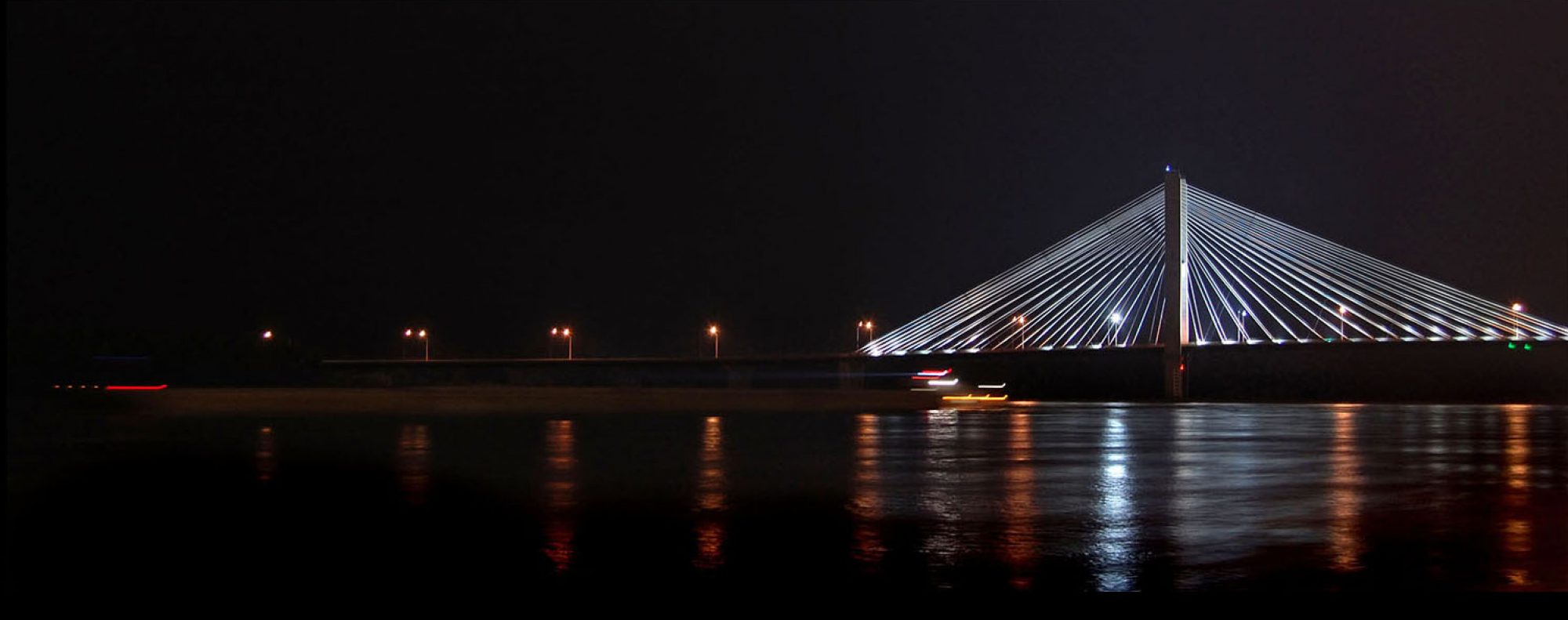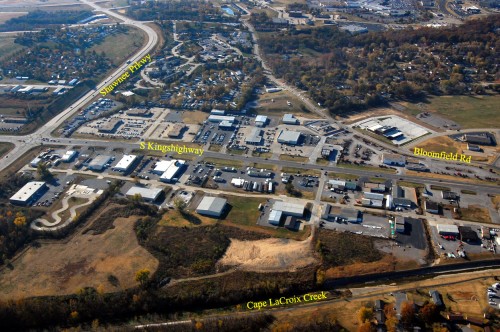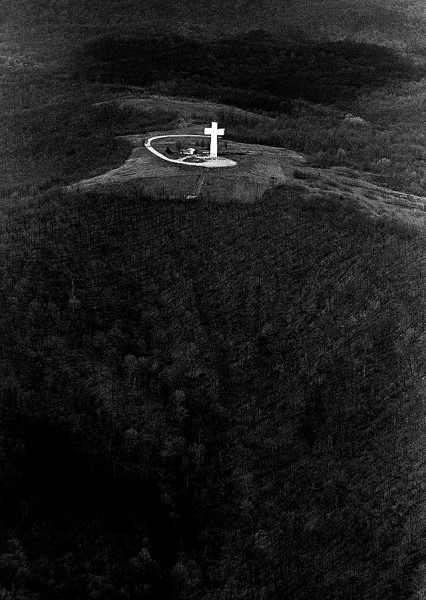 I hadn’t planned to fly Cape Air. In fact, I hadn’t planned to do any flying unless it was another photo flight with Ernie Chiles.
I hadn’t planned to fly Cape Air. In fact, I hadn’t planned to do any flying unless it was another photo flight with Ernie Chiles.
For those of you haven’t been following my car saga, I had some warning lights flicker that the Honda folks interpreted to mean that my transmission was threatening to transmutate into a hunk of inert metal on the side of a very hot highway in the middle of nowhere. I had to find alternative transportation back home so Wife Lila and I could catch a vacation flight to Seattle on Thursday.
After weighing several options:
- Buy a new car in less than 24 hours. (Holy cow! I wanted a car, not a house).
- Buy a junker used car in less than 24 hours. (Why would I think a used car with 140,000 miles on it is any more reliable than my van with 140,000 miles on?)
- Leave my bike and computer stuff behind, fly home, go to Seattle, figure out what we’re going to do for transportation, then drive back to Cape to pick up my stuff.
Door number three was the winner.
I had to get up at 4 a.m
I was going to have to get up at 4 a.m. Tuesday morning to catch a Cape Air flight to St. Louis, where I would have about 46 minutes to catch a Southwest plane that would take me to Tampa, then West Palm Beach, arriving at noonish.
By the time I had packed all my stuff, backed up a hard drive to take with me, and filed a couple of stories in advance, it was 20 minutes to 4, hardly worth thinking about going to bed. The night before, my mother insisted on setting her alarm “in case your alarm doesn’t go off.”
I stretched out, hoping to catch 20 minutes of sleep. At 10 minutes to 4, mother came in to tell me that her alarm had gone off. Her clock was fast. I closed my eyes again. Seven minutes later, she turned on the lights. “It’s time to get up,” she said in a voice that made me think I was back in the third grade.
I got up, had a quick breakfast, took a shower, loaded up the car and pulled into the Cape Airport. I noticed two things: half of the sign welcoming us to the regional airport was burned out, and some patchy ground fog.
Concealed weapons not allowed
 If was comforting to see that I wouldn’t be shot by anyone carrying a concealed weapon, so long as they could read. On the other hand, they might take the sign to mean that it’s bad to conceal the weapon, but OK to start blasting away with one carried openly. That’s too much to ponder so early in the morning.
If was comforting to see that I wouldn’t be shot by anyone carrying a concealed weapon, so long as they could read. On the other hand, they might take the sign to mean that it’s bad to conceal the weapon, but OK to start blasting away with one carried openly. That’s too much to ponder so early in the morning.
Handy terminal map
 As soon as you step into the terminal, you are greeted by this handy map. I was pleased to see that someone had a sense of humor. It reads (in case you haven’t clicked on the image to make it larger), “Okay, so maybe the map isn’t really necessary. But that’s the great thing about flying Cape. Our airport is small, personal and people friendly. You’ll never get lost here – or lost in the shuffle. So welcome. And thanks for flying Cape.”
As soon as you step into the terminal, you are greeted by this handy map. I was pleased to see that someone had a sense of humor. It reads (in case you haven’t clicked on the image to make it larger), “Okay, so maybe the map isn’t really necessary. But that’s the great thing about flying Cape. Our airport is small, personal and people friendly. You’ll never get lost here – or lost in the shuffle. So welcome. And thanks for flying Cape.”
I might quibble with some of the punctuation (or lack of), but it set the right tone for my experience.
Cape Airport isn’t exactly bustling
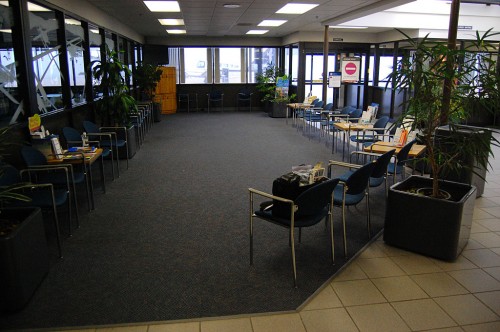 The waiting room had plenty of empty seats.
The waiting room had plenty of empty seats.
Meet perky Jennifer Huffman
 On the way by, three friendly TSA agents said I’d have to get a boarding pass, then they’d start screening passengers about 15 minutes before boarding. They said pictures were OK except of the x-ray monitor when they were viewing the bags. We stood around chewing the fat for about 20 minutes.
On the way by, three friendly TSA agents said I’d have to get a boarding pass, then they’d start screening passengers about 15 minutes before boarding. They said pictures were OK except of the x-ray monitor when they were viewing the bags. We stood around chewing the fat for about 20 minutes.
Jennifer Huffman, perkier than anyone should be at that hour of the morning was behind the the Cape Air counter. There was no serpentine Walt Disney World-type line to wind through.
I handed her a business card and asked for permission to take her picture. She looked at it, then said, “I read your stuff. You wrote that you were going to have to get up early.” After we had talked a bit, she went back behind the counter and came back with a framed photo of the St. Louis Arch she had taken. “I’ll see if the pilot can get you close to it,” she said.
Plenty of time to check out the lobby
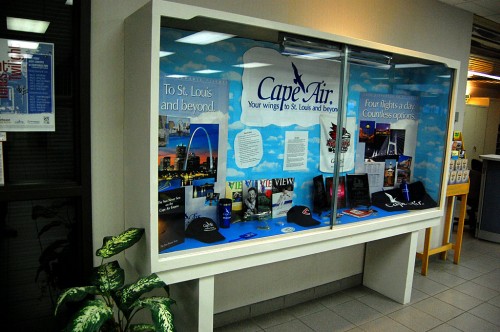 Cape Air memorabilia was tastefully displayed in the lobby next to Security.
Cape Air memorabilia was tastefully displayed in the lobby next to Security.
Collection of photos
 On another wall was a collection of photos of the Cape Air team. I liked them as well or better than the fancy display.
On another wall was a collection of photos of the Cape Air team. I liked them as well or better than the fancy display.
This is not good
 No, I don’t mean the breakfast rolls (which I recognized as coming from Sam’s). I mean all of that condensation on the window.
No, I don’t mean the breakfast rolls (which I recognized as coming from Sam’s). I mean all of that condensation on the window.
A Cape cop came in to provide crowd control. “It’s really foggy out there. I couldn’t even see the airport from the Interstate.”
“Are you my passenger?”
Just then, a fellow in a uniform walked up and asked, “Are you my passenger?”
(That sounded like the old Ozark Airlines days when you’d call to ask what time the next flight left for St. Louis and they’d answer, “When can you make it?”)
“Only if you show me your birth certificate to prove that you’re old enough to buy a drink.” He looked like he was about 12.
Side note: we chartered a lot of small planes in West Palm Beach. We had one pilot we all liked because he’d fly where you wanted to go (“Land on that dike? Sure. I’ll have to dodge some power lines, but…”) and as low as we wanted, FAA regulations and good sense be darned. I don’t remember his middle and last names, but his first name was “Crazy.” He’d greet new passengers by saying, “I’m a hot-s pilot and I’ve got the epaulettes on my shirt to prove it.”
I looked at my 12-year old pilot and saw he had epaulettes, so I showed him some respect.
“I have bad news. The fog has us grounded. We’re going to be delayed at least an hour until it burns off.”
This plane’s not going anywhere
 I did some quick math. “At least an hour” means at least 60 minutes. My layover time in St. Louis was about 46 minutes. Looks like I’m not getting on THIS plane.
I did some quick math. “At least an hour” means at least 60 minutes. My layover time in St. Louis was about 46 minutes. Looks like I’m not getting on THIS plane.
Jennifer moved me to the 1:45
 When Jennifer heard about my plight, you’d have thought she was personally responsible for the fog bank moving in from the way she apologized for the inconvenience.
When Jennifer heard about my plight, you’d have thought she was personally responsible for the fog bank moving in from the way she apologized for the inconvenience.
Jennifer moved me to her 1:45 flight and Wife Lila started working on finding some Southwest connections I could make. Between our first conversation and this one, Jennifer went to the blog and discovered photos of her kids at the Cape – Jackson game I covered last fall. She was excited.
I went home and slept for a couple of hours, then edited the morning’s photos.
Weight and balance important
 By one o’clock, the fog was gone, the skies were clear with some puffy clouds here and there, and the crew was preparing our Cessna 420 for departure.
By one o’clock, the fog was gone, the skies were clear with some puffy clouds here and there, and the crew was preparing our Cessna 420 for departure.
Weight and where it goes is critical in a small plane. Each passenger was asked his or her weight (on the honor system, I suppose. Unless the counter clerk adds a few pounds if wish and reality are too far apart.) I don’t remember what my suitcase weighed, but it earned a “Heavy” sticker. My computer bag was 22 pounds. “I won’t bother to weigh your camera,” I was told.
Roscoe (see below) had a stroller bigger than my first apartment. It wouldn’t fit in any of the usual luggage compartments, so it was placed in the back of the aircraft. There was much head scratching and moving around of luggage to offset its weight in the rear.
Roscoe was my seat partner
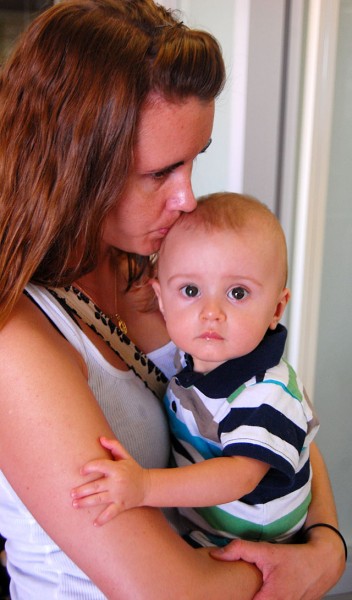 Terra, her husband and 8-1/2-month-old Roscoe were on their way to Alaska to see Roscoe’s grandparents. He was a great seat partner. He didn’t have much to say, didn’t take up much room and was cute. Even when the flight got a bit bumpy he didn’t need the barf bag. He got that all out of his system while we were waiting to board. Because we had already cleared security, a Cape Air employee gave Terra a bottle of water for a quick clean-up.
Terra, her husband and 8-1/2-month-old Roscoe were on their way to Alaska to see Roscoe’s grandparents. He was a great seat partner. He didn’t have much to say, didn’t take up much room and was cute. Even when the flight got a bit bumpy he didn’t need the barf bag. He got that all out of his system while we were waiting to board. Because we had already cleared security, a Cape Air employee gave Terra a bottle of water for a quick clean-up.
Cozy, but not cramped
 I like small planes. I hate being treated like cattle on the big ones. If I can drive there in less than 24 hours, put me in a car.
I like small planes. I hate being treated like cattle on the big ones. If I can drive there in less than 24 hours, put me in a car.
I like being close enough to the pilot to be able to read all the gauges. It’s cool to see your airspeed, rate of climb, altitude and all the rest. You can tell whether the pilot is concerned or if it’s just another day of driving the bus for her.
With all of the government cutbacks, there’s no money left to patch the potholes in the sky. Our pilot did a pretty good job dodging them, but we had a few good bounces from time to time. That just added to the experience.
You’re not flying high
 You plow your way through some of the clouds that an airliner would go way over. You are, at most, about a mile in the sky, not six miles. Features on the ground are easily identifiable. That orange-colored area in the center of the photo is land being cleared for what is rumored to be a minor league ball park (or not).
You plow your way through some of the clouds that an airliner would go way over. You are, at most, about a mile in the sky, not six miles. Features on the ground are easily identifiable. That orange-colored area in the center of the photo is land being cleared for what is rumored to be a minor league ball park (or not).
Conditions aren’t ideal for aerial photography.
- I like to shoot at the FAA minimum altitude over populated areas – 1,000 feet. We were probably twice that high here.
- I like to remove the door of the aircraft or, at least, fix it so the window will open. Commercial airliners frown on that. I’m pretty sure there were no air marshals on our flight, but I think someone would have stopped me if I had tried to remove the window.
- The window has a bit of a color cast to it and you have to deal with reflections. I shoot with a polarizing filter on the lens that helps cut through the haze and eliminate as much glare from the glass as possible.
- The largest windows are over the wing, so I picked the largest one behind that wing to keep from having my view blocked. The first officer said I should be on the right side of the plane if I wanted to see the Arch.
[Note: excuse in advance. I normally edit my photos on a color-calibrated monitor for consistency. If the pictures don’t look right while I’m on the road, it’s because I’m working on a laptop. If you change the angle of the screen, it changes the brightness of the image, so you never know exactly what’s right. My apologies.]
You don’t blast off like a rocket
 Everything moves more slowly in a small plane. You don’t rocket into space. You have a leisurely climb to altitude that lets you pick out local landmarks like the Bill Emerson Memorial Bridge on the left and Cape LaCroix Creek joining the Mississippi river at bottom right. You can see that a substantial portion of East Cape is still covered in water. The river splits on the right to go around Marquette Island.
Everything moves more slowly in a small plane. You don’t rocket into space. You have a leisurely climb to altitude that lets you pick out local landmarks like the Bill Emerson Memorial Bridge on the left and Cape LaCroix Creek joining the Mississippi river at bottom right. You can see that a substantial portion of East Cape is still covered in water. The river splits on the right to go around Marquette Island.
No fancy jetways for Cape Air
 All too soon, we were on final for the St. Louis airport. Approach control routed us a little too far south to shoot the arch through the haze, unfortunately. When we were way south of it, it picked up some rays of the sun and gleamed back at us, but I didn’t even try for a shot. (The First Officer apologized for not being able to get closer. See if that ever happens when you fly Delta.)
All too soon, we were on final for the St. Louis airport. Approach control routed us a little too far south to shoot the arch through the haze, unfortunately. When we were way south of it, it picked up some rays of the sun and gleamed back at us, but I didn’t even try for a shot. (The First Officer apologized for not being able to get closer. See if that ever happens when you fly Delta.)
You don’t have to wait for the ground crew to maneuver a fancy jetway to disembark. As soon as the plane stops rolling, the door is opened, you’re told to stand behind the wing for safety reasons, and someone hands you your carry-on luggage (which isn’t really carried on: it’s placed in a luggage compartment). Any checked bags are sent to the baggage carousel.
Bill Adams was on the flight
 In an interesting coincidence, Bill Adams (striped shirt) and his wife were on the flight, also headed to Seattle. You might remember that he was the fellow who built a huge American Flag out of red, white and blue license tags. They’re going up to visit their daughters. I kept trying to convince Bill to switch to digital photography, but he’s still a film guy.
In an interesting coincidence, Bill Adams (striped shirt) and his wife were on the flight, also headed to Seattle. You might remember that he was the fellow who built a huge American Flag out of red, white and blue license tags. They’re going up to visit their daughters. I kept trying to convince Bill to switch to digital photography, but he’s still a film guy.
Passengers, not two-legged freight
If you want to rediscover what flying was like when passengers were considered important and not two-legged freight, hop a flight on Cape Air. Everyone from the ground crew, to the flight crew, to Jennifer at the counter was friendly and helpful. Even the two men and woman with the TSA were relaxed and willing to trade stories.
Cape Air is cheaper and faster than the ground transportation option I had considered. If you want to see Southeast Missouri from a new perspective, the small commuter airliner is the way to do it.
